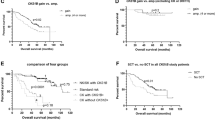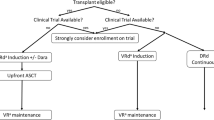Abstract
Deletions involving chromosome 1p are frequent events in multiple myeloma (MM). As karyotyping and single nucleotide polymorphism-based mapping analysis identify a minimal common deletion region involving the 1p21 locus, we investigated the prevalence and prognostic significance of del(1p21) in 203 MM patients undergoing high-dose therapy and autologous SCT. 1p21 status was also evaluated in 16 patients with monoclonal gammopathy of undetermined significance (MGUS) and 41 patients with plasma cell leukemia (PCL). FISH combined with cytoplasmic light chain detection (cIg-FISH) detected hemizygous 1p21 deletions in 18% of the MM, 34% of PCL but none of the MGUS cases. The presence of 1p21 deletions was correlated with 1q21(CKS1B) amplification (P=0.01), and del17p(TP53) (P=0.05) but not with del(13q), t(11;14) or t(4;14). Patients with 1p21 deletions had significantly shorter progression-free survival (PFS; median 14.2 vs 25.4 months, P<0.001) and overall survival (OS; median 39.4 vs 82.3 months, P=0.001) than those without such deletions. In multivariate analysis, del(1p21) was an independent risk factor for PFS (P= 0.003) and OS (P=0.013) after adjusting for del(13q), del(p53), t(4;14) and 1q21 amplifications. Our results indicate that del(1p21) is an independent poor prognostic factor associated with disease progression in MM.
This is a preview of subscription content, access via your institution
Access options
Subscribe to this journal
Receive 12 print issues and online access
$259.00 per year
only $21.58 per issue
Buy this article
- Purchase on Springer Link
- Instant access to full article PDF
Prices may be subject to local taxes which are calculated during checkout

Similar content being viewed by others
References
Sawyer JR, Waldron JA, Jagannath S, Barlogie B . Cytogenetic findings in 200 patients with multiple myeloma. Cancer Genet Cytogenet 1995; 82: 41–49.
Debes-Marun CS, Deqald GW, Bryant S, Picken E, Santana-Davila R, Gonzalez-Paz N et al. Chromosome abnormalities clustering and its implications for pathogenesis and prognosis in myeloma. Leukemia 2003; 17: 427–436.
Cigudosa JC, Rao PH, Calasanz MJ, Odero MD, Michalli J, Jhanwar SC et al. Characterization of nonrandom chromosomal gains and losses in multiple myeloma by comparative genomic hybridization. Blood 1998; 91: 3007–3010.
Walker BA, Leone PE, Jenner MW, Li C, Gonzalez D, Johnson DC et al. Integration of global SNP-based mapping and expression arrays reveals key regions, mechanisms, and genes important in the pathogenesis of multiple myeloma. Blood 2006; 108: 1733–1734.
Marzin Y, Jamet D, Douet-Guilbert N, Morel F, Le Bris M, Morice P et al. Chromosome 1 abnormalities in multiple myeloma. Anticancer Res 2006; 26: 953–960.
Chang H, Qi C, Xu W, Patterson B . 1p21 deletion is a novel poor prognostic factor in multiple myeloma. Br J Haematol 2007; 139: 51–54.
Chang H, Samiee S, Qi WY, Yi QL, Mikhael J, Chen CI et al. Genetic risk identifies myeloma patients who do not benefit from autologous stem cell transplantation. Bone Marrow Transplant 2005; 36: 793–796.
Chang H, Yeung J, Xu W, Ning Y, Patterson B . A significant increase of CKS1B amplification from MGUS to multiple myeloma and plasma cell leukemia as demonstrated by interphase fluorescence in situ hybridization. Br J Haematol 2006; 134: 613–615.
Fonseca R, Barlogie B, Bataille R, Bastard C, Bergsagel PL, Chesi M et al. Genetics and cytogenetics of multiple myeloma: a workshop report. Cancer Res 2004; 64: 1546–1548.
Wu KL, Beverloo B, Lokhorst HM, Segeren CM, van der Holt B, Steijaert MM et al. Abnormalities of chromosome 1p/q are highly associated with 13/13qdletions and are an adverse prognostic factor for the outcome of high-dose chemotherapy in patients with multiple myeloma. Br J Haematol 2007; 136: 615–623.
Qazilbash MH, Saliba RM, Ahmed B, Parikh G, Mendoza F, Ashraf N et al. Deletion of short arm of chromosome 1 (del1p) is a strong predictor of poor outcome in myeloma patients undergoing an autotransplant. Biol Blood Marrow Transplant 2007; 13: 1066–1072.
Hanamura I, Stewart JP, Huang Y, Zhan F, Santra M, Sawyer JR et al. Frequent gain of chromosome band 1q21 in plasma-cell dyscrasias detected by fluorescence in situ hybridization: incidence increases from MGUS to relapsed myeloma and is related to prognosis and disease progression following tandem stem-cell transplantation. Blood 2006; 108: 1724–1732.
Chang H, Qi XY, Trieu Y, Xu W, Reeder RC, Ning Y et al. Multiple myeloma patients with CKS1B amplification have a poor progression free survival post-autologous stem cell transplantation. Br J Haematol 2006; 135: 486–491.
Fonseca R, Van Wier SA, Chng WJ, Ketterling R, Lacy MQ, Dispenzieri A et al. Prognostic value of chromosome 1q21 gain by fluorescent in situ hybridization and increase CKS1B expression in myeloma. Leukemia 2006; 20: 2034–2040.
Fonseca R, Bailey RJ, Ahmann GJ, Rajkumar SV, Hoyer JD, Lust JA et al. Genomic abnormalities in monoclonal gammopathy of undetermined significance. Blood 2002; 100: 1417–1424.
Kaufmann H, Ackermann J, Baldia C, Nosslinger T, Wieser R, Seidl S et al. Both IGH translocations and chromosome 13q deletions are early events in monoclonal gammopathy of undetermined significance and do not evolve during transition to multiple myeloma. Leukemia 2004; 18: 1879–1882.
Rasnussen T, Kuehl M, Lodahl M, Johnsen HE, Dahl IM . Possible roles for activating RAS mutations in the MGUS to MM transition and in the intramedullary to extramedullary transition in some plasma cell tumors. Blood 2005; 105: 317–323.
Shaughnessy JD, Zhan F, Burington BE, Huang Y, Colla S, Hanamura I et al. A validated gene expression model of high-risk multiple myeloma is defined by deregulated expression of genes mapping to chromosome 1. Blood 2007; 15: 2276–2284.
Wong AK, Chen Y, Lian L, Ha PC, Petersen K, Laity K et al. Genomic structure, chromosomal location, and mutation analysis of the human CDC14A gene. Genomics 1999; 59: 248–251.
Mailand N, Lukas C, Kaiser BK, Jackson PK, Bartek J, Lukas J . Deregulated human Cdc14A phosphatase disrupts centrosome separation and chromosome segregation. Nat Cell Biol 2002; 4: 317–322.
Paulsen MT, Starks AM, Derheimer FA, Hanasoge S, Li L, Dixon JE et al. The p53-targeting human phosphatase hCdc14A interacts with the CdkI/cyclin B complex and is differentially expressed in human cancers. Mol Cancer Res 2006; 5: 25.
Acknowledgements
This study was supported in part by a grant from Canadian Institute of Health Research (CIHR), Cancer Research Society Inc. and Leukemia and Lymphoma Society of Canada to HC.
Author information
Authors and Affiliations
Corresponding author
Rights and permissions
About this article
Cite this article
Chang, H., Qi, X., Jiang, A. et al. 1p21 deletions are strongly associated with 1q21 gains and are an independent adverse prognostic factor for the outcome of high-dose chemotherapy in patients with multiple myeloma. Bone Marrow Transplant 45, 117–121 (2010). https://doi.org/10.1038/bmt.2009.107
Received:
Revised:
Accepted:
Published:
Issue Date:
DOI: https://doi.org/10.1038/bmt.2009.107
Keywords
This article is cited by
-
Chromosome 1q21 abnormalities in multiple myeloma
Blood Cancer Journal (2021)
-
The survival impact of CKS1B gains or amplification is dependent on the background karyotype and TP53 deletion status in patients with myeloma
Modern Pathology (2021)
-
Clinical characteristics and prognostic values of 1p32.3 deletion detected through fluorescence in situ hybridization in patients with newly diagnosed multiple myeloma: a single-center study in China
Frontiers of Medicine (2020)
-
Gain of Chromosome 1q is associated with early progression in multiple myeloma patients treated with lenalidomide, bortezomib, and dexamethasone
Blood Cancer Journal (2019)
-
Expert Panel Consensus Statement for Proper Evaluation of First Relapse in Multiple Myeloma
Current Hematologic Malignancy Reports (2019)



